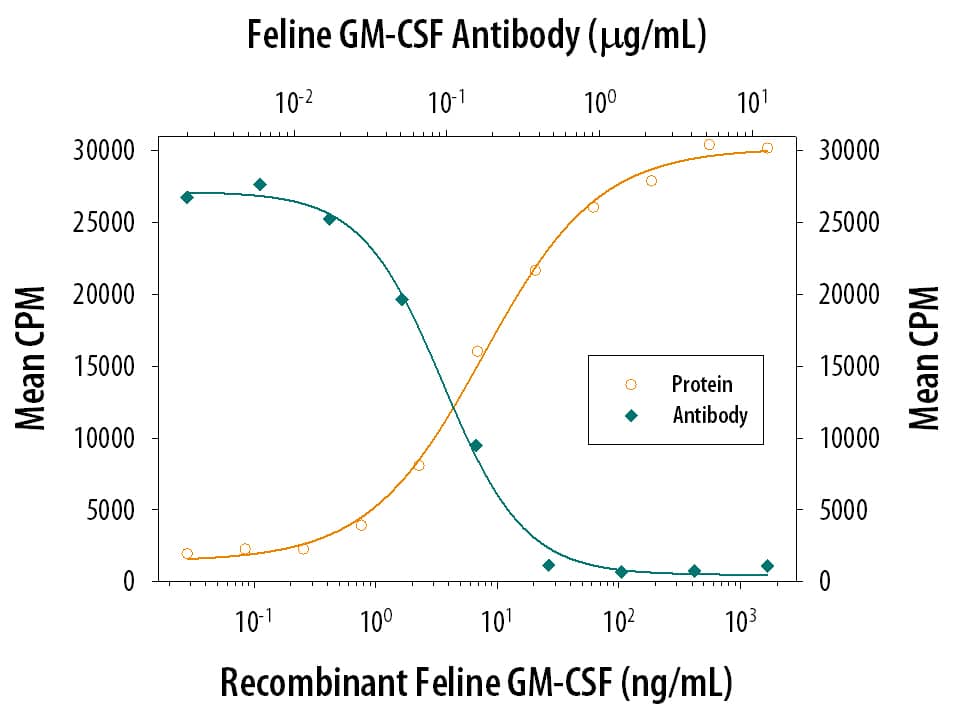Feline GM-CSF Antibody
R&D Systems, part of Bio-Techne | Catalog # MAB9871

Key Product Details
Species Reactivity
Applications
Label
Antibody Source
Product Specifications
Immunogen
Ala18-Lys144 (Met36Ile, Thr56Ala & Lys126Asn)
Accession # AAC06041
Specificity
Clonality
Host
Isotype
Endotoxin Level
Scientific Data Images for Feline GM-CSF Antibody
Cell Proliferation Induced by GM-CSF and Neutralization by Feline GM-CSF Antibody.
Recombinant Feline GM-CSF (Catalog # 987-FL) stimulates proliferation in the TF-1 human erythroleukemic cell line in a dose-dependent manner (orange line). Proliferation elicited by Recombinant Feline GM-CSF (50 ng/mL) is neutralized (green line) by increasing concen-trations of Mouse Anti-Feline GM-CSF Monoclonal Antibody (Catalog # MAB9871). The ND50 is typically 0.1-0.4 µg/mL.Applications for Feline GM-CSF Antibody
Neutralization
Formulation, Preparation, and Storage
Purification
Reconstitution
Formulation
Shipping
Stability & Storage
- 12 months from date of receipt, -20 to -70 °C as supplied.
- 1 month, 2 to 8 °C under sterile conditions after reconstitution.
- 6 months, -20 to -70 °C under sterile conditions after reconstitution.
Background: GM-CSF
GM-CSF was initially characterized as a factor that can support the in vitro colony formation of granulocyte-macrophage progenitors. It is also a growth factor for erythroid, megakaryocyte, and eosinophil progenitors. GM-CSF is produced by a number of different cell types (including T cells, B cells, macrophages, mast cells, endothelial cells, fibroblasts, and adipocytes) in response to cytokine or inflammatory stimuli. On mature hematopoietic cells, GM-CSF is a survival factor for and activates the effector functions of granulocytes, monocytes/macrophages, and eosinophils (1, 2). GM-CSF promotes a Th1 biased immune response, angiogenesis, allergic inflammation, and the development of autoimmunity (3‑5). It shows clinical effectiveness in ameliorating chemotherapy-induced neutropenia, and GM-CSF transfected tumor cells are utilized as cancer vaccines (6, 7). The 22 kDa glycosylated GM-CSF, similar to IL-3 and IL-5, is a cytokine with a core of four bundled alpha-helices (8‑10). Mature feline GM-CSF shares 52%‑56% amino acid sequence identity with mouse and rat GM-CSF and 67%‑72% canine, human, and porcine GM-CSF. GM-CSF exerts its biological effects through a heterodimeric receptor complex composed of GM-CSF R alpha/CD116 and the signal transducing common beta chain (CD131) which is also a component of the high-affinity receptors for IL-3 and IL-5 (11, 12). In addition, GM-CSF binds a naturally occurring soluble form of GM-CSF R alpha (13). Feline and human GM-CSF show cross-species activity (14, 15).
References
- Martinez-Moczygemba, M. and D.P. Huston (2003) J. Allergy Clin. Immunol. 112:653.
- Barreda, D.R. et al. (2004) Dev. Comp. Immunol. 28:509.
- Eksioglu, E.A. et al. (2007) Exp. Hematol. 35:1163.
- Cao, Y. (2007) J. Clin. Invest. 117:2362.
- Fleetwood, A.J. et al. (2005) Crit. Rev. Immunol. 25:405.
- Heuser, M. et al. (2007) Semin. Hematol. 44:148.
- Hege, K.M. et al. (2006) Int. Rev. Immunol. 25:321.
- Kaushansky, K. et al. (1992) Biochemistry 31:1881.
- Diederichs, K. et al. (1991) Science 254:1779.
- Dunham, S.P. and J. Bruce (2004) Gene 332:97.
- Onetto-Pothier, N. et al. (1990) Blood 75:59.
- Hayashida, K. et al. (1990) Proc. Natl. Acad. Sci. 87:9655.
- Pelley, J.L. et al. (2007) Exp. Hematol. 35:1483.
- Sprague, W.S. et al. (2005) J. Comp. Pathol. 133:136.
- Dunham, S.P. and J. Bruce (2004) Gene 332:97.
Long Name
Alternate Names
Entrez Gene IDs
Gene Symbol
UniProt
Additional GM-CSF Products
Product Documents for Feline GM-CSF Antibody
Product Specific Notices for Feline GM-CSF Antibody
For research use only
